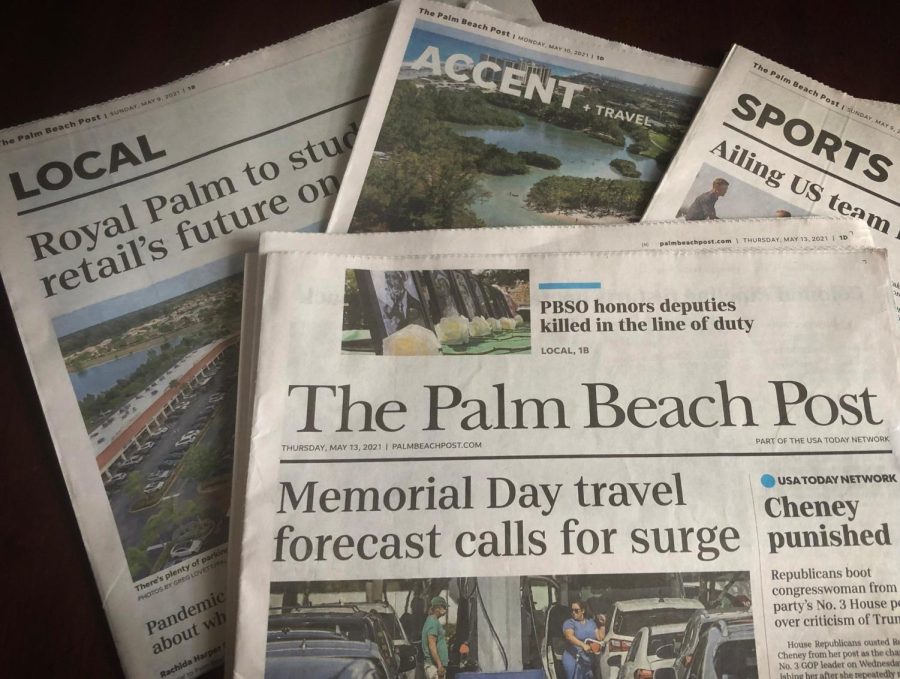Will the Pandemic Save Local News?
Greg Lovett/The Palm Beach Post/TNS
The Palm Beach Post newspaper in West Palm Beach, Florida in 2021.
January 7, 2022
Phone lines were busy, and health center websites were crashing from traffic overloads. Breaking news reporter for The Miami Herald Michelle Marchante recalls being ŌĆ£swarmedŌĆØ with emails and phone calls in early 2021 after publishing information about COVID-19 vaccine sites in South Florida. Hoping to protect themselves and their families from the deadly virus, residents turned to their local newspaper for information ŌĆö┬Āwhat Marchante calls a ŌĆ£perfect exampleŌĆØ of the essentiality of community-level reporting.
According to UNC Hussman School research, throughout the last 20 years, the United States has lost approximately one-fourth of its newspapers. In some regions, news production has diminished to the point that communities are now classified as ŌĆ£news desertsŌĆØ, lacking access to credible publications informing citizens about events and issues. The publications disappearing the fastest are local newspapers.
Among the challenges many local newspapers face today are funding strategies and competition with larger-scale news outlets, which can report on large issues at a far faster pace. In a recent survey conducted from about 200 members of the school community, 68% of participants stated that they were subscribers to national news sources, while only 34% were subscribers to a local news source. Additionally, with less print circulation due to the popularity of digital news, local newspapers also receive less funding from advertisers.┬Ā
The Miami Herald has made a multitude of changes in the last decade to adapt to this evolving news environment. One is continuing to stray further from print editions, closing its printing headquarters and ceasing circulation of Saturday papers in 2020. Another is transitioning over time to a subscriber-based funding model, rather than an ad-based one, in which returning readers must pay a subscription fee to access most online articles.
ŌĆ£Local newspapers really depend on their own communities to fund them,ŌĆØ said Marchante, who began writing for the Herald in 2019. ŌĆ£With the subscriber-based model, the idea is that the people who read us will be able to pay to keep the newspaper afloat. But the stories that are essential to the community, like COVID stories, are free.ŌĆØ
Another role of local news is its importance in fueling and encouraging civic engagement. Gallup and the Knight FoundationŌĆÖs 2020 ŌĆ£American ViewsŌĆØ report states that Americans who follow local news are more likely to participate in local elections. This expands to other forms of civic engagement, such as volunteering and activism.
ŌĆ£I really do believe that local news is the most important news, especially now that IŌĆÖm actually in it,ŌĆØ said Marchante. ŌĆ£At the end of the day, people see that the news that most affects their daily lives is what we cover.ŌĆØ
There appears an interdependent relationship between local newspapers and local issues: without local issues, local newspapers struggle to compete with national outlets; without local newspapers, citizens struggle to be informed about the issues that most impact their quotidian lives and surroundings. Miami residents observed this service as citizens depended on local reporters to provide information and updates on vaccine and test sites, changing safety measures, and local government policies as the pandemic raged.
Local newspapers, in providing essential information relevant to only a particular region or community, have increased the value of local news since the onset of the coronavirus pandemic. This renewed value has even forged growth in the local news industry ŌĆö according to Poytner, more than 70 local newsrooms and 50 local newsletters launched in the United States within the last two years.┬Ā
In Florida, communities with recently launched local newsrooms include Key Biscayne, Obiedo, Jacksonville, Sarasota, Winter Garden, and more. Meanwhile, the MiamiŌĆÖs Community News umbrella continues to run 11 printed newspapers serving from Cutler Bay to Aventura. Those involved in local reporting attest that community newspapers contain a value and essentiality that separates them from the larger and more widespread news outlets.
ŌĆ£We donŌĆÖt compare ourselves to the other people, and we just want to make sure that we are providing a good product on local issues,ŌĆØ commented Grant Miller, publisher of MiamiŌĆÖs Community News for over 40 years. ŌĆ£Local newspapers have never been stronger.ŌĆØ


















